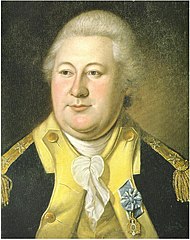Glimpses of Early Blandford
As long as we’re out in Blandford with Henry Knox, we might as well enjoy the town’s eighteenth-century history.
Most of the first British settlers in the area were Scotch-Irish, moving west in a bunch from Hopkinton in 1736. They named their new community “Glasgow” or “New Glasgow.” The town’s first meetinghouse was Presbyterian rather than New England Congregationalist.
However, when the Massachusetts government formally incorporated the town in 1741, the new governor, William Shirley, insisted on naming it after the ship that he had just arrived on—the Blandford. Reportedly he had leverage because the town proprietors had claimed more land than they were entitled to, so they needed the governor’s approval more than the inhabitants’.
The name “Glasgow” survived in a few geographic names such as the “Glasgow or Westfield Mountain” that Knox referred to in his diary. The town reportedly lost a church bell that the city of Glasgow, Scotland, had promised if it kept its original name.
Blandford was on the Massachusetts frontier, thus at risk from the French and their Native allies. During 1749, almost every household fled to other towns for safety. In 1755, as war loomed again, the town petitioned the Massachusetts General Court for a swivel gun, a type of small cannon. It was stored at the house of the Rev. James Morton.
The town straddled one of the few roads through the Berkshire Mountains, so it saw a lot of traffic. In 1762 a tavern keeper named Joseph Clark petitioned the legislature to be forgiven for selling alcohol without paying the excise tax. His excuse:
Blandford grew quickly after the Revolutionary War. Growth brought change, as preserved in this family anecdote from local historian William H. Gibbs. He said that around 1791 Isaac Gibbs (1744-1823)
Most of the first British settlers in the area were Scotch-Irish, moving west in a bunch from Hopkinton in 1736. They named their new community “Glasgow” or “New Glasgow.” The town’s first meetinghouse was Presbyterian rather than New England Congregationalist.
However, when the Massachusetts government formally incorporated the town in 1741, the new governor, William Shirley, insisted on naming it after the ship that he had just arrived on—the Blandford. Reportedly he had leverage because the town proprietors had claimed more land than they were entitled to, so they needed the governor’s approval more than the inhabitants’.
The name “Glasgow” survived in a few geographic names such as the “Glasgow or Westfield Mountain” that Knox referred to in his diary. The town reportedly lost a church bell that the city of Glasgow, Scotland, had promised if it kept its original name.
Blandford was on the Massachusetts frontier, thus at risk from the French and their Native allies. During 1749, almost every household fled to other towns for safety. In 1755, as war loomed again, the town petitioned the Massachusetts General Court for a swivel gun, a type of small cannon. It was stored at the house of the Rev. James Morton.
The town straddled one of the few roads through the Berkshire Mountains, so it saw a lot of traffic. In 1762 a tavern keeper named Joseph Clark petitioned the legislature to be forgiven for selling alcohol without paying the excise tax. His excuse:
That in the Year 1760 He purchased a licensed House and purchased a barrel of Rum, but being sick in August when he should have applied for a license, and his House lying in the Road used by Soldiers sold the same, out to them: and he boght the said Rum of a Retailer who had paid the Duties of excise thereon—The Massachusetts House bought that argument. The Council disagreed.
Blandford grew quickly after the Revolutionary War. Growth brought change, as preserved in this family anecdote from local historian William H. Gibbs. He said that around 1791 Isaac Gibbs (1744-1823)
brought into town the first single wagon used here. The neighbors regarded it as a curiosity, and their horses as he drove to church the first Sabbath, being affrighted, fled with as much precipitation as they do in our own day at the sight of the steam engine. It was a matter so strange to the people, that they actually proposed to call a town meeting to prohibit the use of wagons.But the problems of growth didn’t last long. In the 1800 U.S. Census, Blandford had a population of 1,778—the largest the town ever was.


